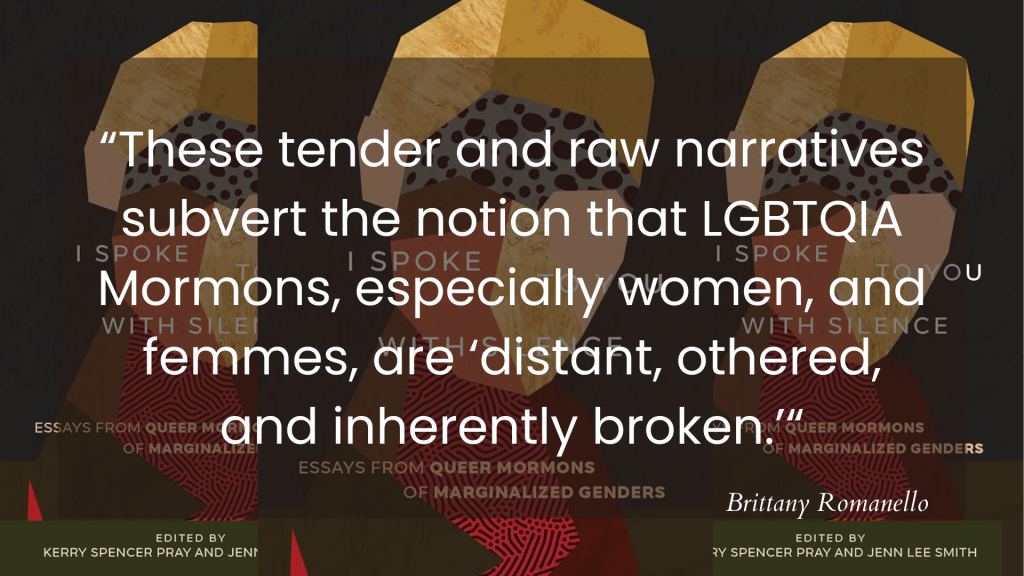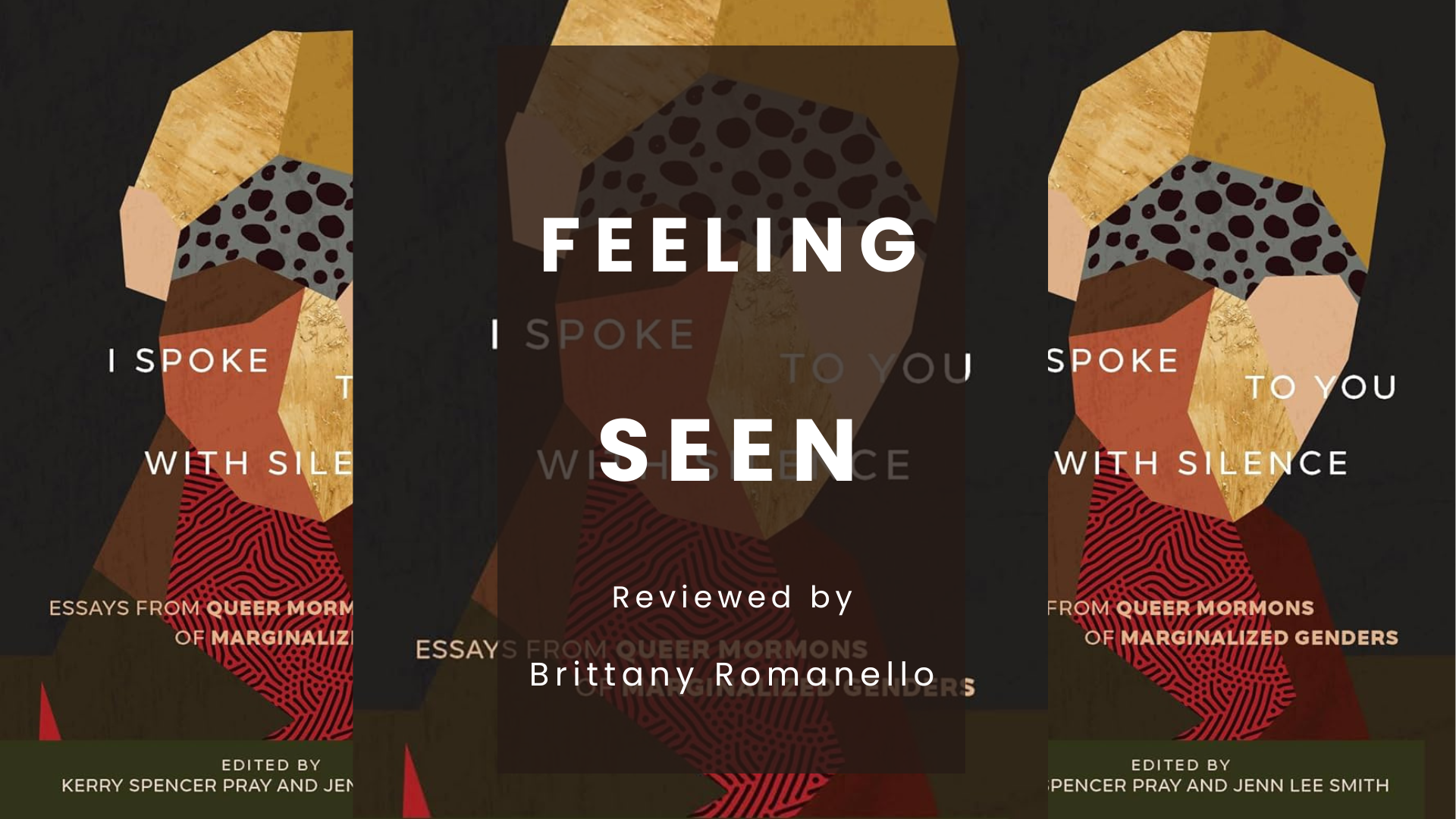Articles/Essays – Volume 57, No. 3
Feeling Seen | Kerry Spencer Pray and Jenn Lee Smith, eds. I Spoke to You with Silence: Essays from Queer Mormons of Marginalized Genders
A content warning: this review discusses abuse, trauma, and suicide.
I didn’t open it for a few months after receiving I Spoke to You with Silence: Essays from Queer Mormons of Marginalized Genders. I had been delighted when asked to review it, but when the time came, anxiety overwhelmed me. I knew I would see myself in this book in an intimate, painful way, even though many of the narratives don’t directly reflect my own lived experiences. It was clear that reading this anthology of essays would make me feel vulnerable, striking close to my little queer heart, but I knew it would be healing to feel seen.
Essays in part 1 focus on identity. Many reflect on the discovery of their queer selves that they “never considered possible” (26). Many share the “expectation of silence” (50) they experienced during their self-discovery and coming out process, especially when considering the other facets of discrimination these writers encountered. Jenn Lee Smith describes how navigating their queer identity felt like “too much to add to a highly sensitive body already dealing with childhood, developmental, race, ethnic immigration, and religious abuse trauma” (40). As a queer, disabled, multiracial person of color, Melissa Malcolm King writes, “I’m stuck in these intersections all the time: between the church, my gender/sexual orientation, and a society that normalizes racism” (52). Finding acceptance in one’s identity is a constant theme. “It’s okay to be disconnected from my ethnic heritage,” Sarah Pace writes. “It is okay to like girls. It is okay to be brown and butch” (29–30). By acknowledging the intersections of multiple marginalized identities, these authors explore how their journeys of self-discovery both hurt and empowered them, seeking ways to be authentic in their identity and “yearning to belong” in Mormonism and broader society (31).
Kerry Spencer Pray introduces part 2 of the essays, “Relationships,” acknowledging that queer Mormon love has long been “taboo” and that LGBTQIA+ community members “don’t seem to have enough words to describe the complexity of our experiences” (55–56). An anonymously written essay encapsulates some of the complicated feelings many of us feel in navigating queer feelings, longings, and acts of love: “We had never . . . crossed the line, but we didn’t need to touch to be bonded. That was the greatest lie of all. That this was only a sin if we touched. That this was only real if we touched. . . . It can’t be gay if you never, ever touch. But I loved you” (64). These tender and raw narratives subvert the notion that LGBTQIA+ Mormons, especially women and femmes, are “distant, othered, and inherently broken” (75). These essays challenge us to recognize beauty and reciprocity that marginalized bodies and genders can offer one another, not just “sex or body parts” (80). As these writers discuss how they began, grew, changed, and ended their relationships, the reader is invited to interrogate their ideas of what gay love looks like and means in Mormonism. To self-actualize, self-accept, and move forward, queer Mormons must navigate dissonances: “The church thinks differently than God thinks” (85).

Part 3, “Essays on Shame, Suicide, and the Closet,” was difficult to read because “More often that we would like to admit . . . the burden of being queer [is] too much to bear” (105). Historical trauma in an almost globally homophobic society and within Mormon teaching and culture leads many to believe that “queer people are expendable” (106). These chapters cover various topics such as erasure, conversion therapy, self-harm, abuse, and suicide. Jaclyn Foster remembers her mother’s comment on an episode of Modern Family when gay couple Cam and Mitchell kiss, telling them to turn off the TV so they wouldn’t “normalize” what they saw. “It wasn’t allowed to be normal,” they write (123). Several times while reading this section, I cried when recalling those I’ve known who have dealt with self-harm and self-hatred and some who have died by suicide because of the shame, stigma, and the “burden” of believing our gayness makes us abnormal, a mistake, or a sin. Jasper Brennan painstakingly describes coming out to their father, the experience that led them to conclude that “the closet is a tough place, but for now, it seems the only option” (116). Despite the heavy content, these essays—painful, brutal, and beautiful—acknowledge and dignify the pain, loss, and resilience of queer Mormons, a strength I wish we didn’t need.
In one of the volume’s final essays, addressing the Church, Taylor Petrey notes that if we are to understand queerness within Mormonism, we must acknowledge “the deeply heteronormative environment that the church has deliberately cultivated” (142). Introspection and diverse conclusions are evident in each essay, especially in light of the ongoing “cultural pressure points” LGBTQIA+ Mormons must face for their faith, for themselves, and for survival (143). Irving Diego Santos recalls feeling “always in a costume, but never comfortable” while feeling pressured to dress in a gender-conforming way, wishing they had “come into the world as a cis man” (169). As Cristina Moraes writes, many feel they have to “live a double life” to keep their faith and live their real identities (164). Mormon theologies make them feel included and seen but also constrained, suffocated, and bound when openly expressing their queerness. For some time, many had resigned themselves to “invisibility in their identities” (178). Others describe how living and participating in Church culture could be much “easier . . . when one isn’t busy pretending to be someone else” (151). I, too, wondered who I might be in the present day if being my “real self” had been both accepted and celebrated during my upbringing within Mormon communities rather than something to be hidden away while I pretended to only like men.
The authenticity and representation of all the authors’ truths are the greatest strengths of this anthology. Naji Haska Runs Through asks, “Am I loveable? Can I have a family? Will I find peace?” (24). The writing reflects the various questions, dualities, and contradictions of queer Mormon lives and experiences. Moreover, readers who are Mormon and call themselves LGBTQIA+ allies are asked to think about what they can do beyond sharing their shame about the Church’s homophobia secretly or on social media (175). These testaments remind us of our connections, the power of community, and the long-lasting complications and damage that continue as the Church institution denies and erases us LGBTQIA+ members’ recognition and autonomy to exist exactly as we are within Mormon spaces. I admire and thank all the authors for their power, vulnerability, and willingness to share their grief and joy with those who are here, as a dedication to those who are gone, and as a witness to those who are yet to be.
Kerry Spencer Pray and Jenn Lee Smith, eds. I Spoke to You with Silence: Essays from Queer Mormons of Marginalized Genders. Salt Lake City: University of Utah Press, 2022. 288 pp. Paper: $24.95. ISBN: 9781647690793.


 Back to full Issue
Back to full Issue

